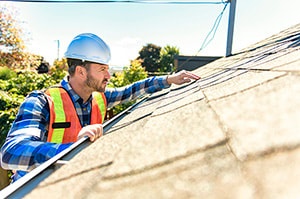 If you are getting ready for spring-cleaning, instead of reaching for household cleaning products that contain environmentally harmful chemicals, first consider giving your home a green spring-cleaning with some eco-friendly, inexpensive products that can be found in your kitchen cupboards. Clean Kitchens and Bathrooms with Vinegar Vinegar is an effective cleaning solution for the kitchen and bathroom. Using a mixture of equal parts water and white vinegar to clean bathroom sinks, bathtubs, floors, and taps will remove hard water stains and make your home sparkle. Vinegar is also an eco-friendly toilet bowl cleaner: Pour undiluted vinegar into the toilet bowl, scrub with a toilet brush, and then flush to rinse. The same solution of vinegar and water can be used to wipe kitchen surfaces and mop floors, but never use vinegar to clean granite or marble. Whenever cleaning with vinegar, always try it on a small area first to make sure it does not damage the surface. Use Lemon to Clean and Deodorize Lemons get rid of unpleasant odors in the kitchen easily and naturally. Scrub your old chopping boards with half a lemon and then put the other half in the fridge to remove odors. Deodorize the drains by pouring a mix of hot water and a little lemon juice down the drain. Bring a refreshing lemon scent into the house by using lemon essential oil for cleaning floors. Lemon oil is a natural but powerful disinfectant, and most people like its fresh fragrance. Add six drops of lemon oil into a 1/2 gallon of lukewarm water, stir well, and use the water to mop the floors or to clean the bathroom. Warning: Do not use lemon essential oil for cleaning wood floors or marble counters as it can cause damage. Scrub Stains with Baking Soda Baking soda (sodium bicarbonate) is an eco-friendly deodorizer and household cleaner that is especially useful in the kitchen. Mix four tablespoons of baking soda with one cup of water and use the mixture to clean your fridge, oven, and microwave, or to get rid of grime on kitchen counters and other surfaces. Let difficult stains soak for a while before wiping them down with a damp cloth. Sprinkle baking soda on pots and pans and scrub to remove the stains.  The National Association of Realtors and the National Association of Landscape Professionals have released a report titled “2023 Remodeling Impact Report: Outdoor Features,” which provides insights into the return on investment (ROI) of various landscaping projects. According to the report, certain outdoor features can increase a home’s value and attract potential buyers. The Power of First Impressions The report found that 92% of Realtors® suggest sellers improve the curb appeal of their homes before listing them for sale. The first impression a potential buyer gets of your home is crucial, and enhancing the exterior of your home is an excellent way to increase its value. The Most Valuable Upgrades The report examined 11 outdoor residential projects, and the outdoor features that provided the highest ROI were standard lawn care service (217% cost recovery), landscape maintenance (104%), an overall landscape upgrade (100%), and an outdoor kitchen (100%). These projects are not only affordable but also provide high returns on investment. Consumer Experience Matters The report also rated the consumer experience on a Joy Score scale of 1-10 for each project. The highest-rated projects were an in-ground pool addition (10), landscape lighting (10), and a new patio (9.9). Other projects such as tree care, outdoor kitchen, standard lawn care service, and an irrigation system installation also scored high on the Joy Score scale. Meeting Homeowner Demands Landscape professionals saw increased demand for specific projects over the last year, including an overall landscape upgrade (61%), landscape maintenance (58%), and a new patio (55%). While these projects may not provide the highest cost recovery, they are an excellent way to improve the overall look and feel of your outdoor space.  The roof over your head is a critical part of your home. Roofs protect you from rain, wind, and snow, and it’s easy to take them for granted. But if a roof is outdated, it can lead to people or property damage. Most roofing materials have a life span of 20-25 years, including wood shake roofs and roofs with fiber cement shingles. If you have a slate or copper roof, it can last twice as long. Weather and climate conditions can also affect the life span of your roof. It’s essential to know when it’s time to replace your roof to avoid potential damage. To do this, you can check the warranty documents that came with your home for the installation date or contact a professional to assess the condition of your roof. Here are five signs that indicate you need a new roof: Damaged or Missing Shingles If you can easily spot missing or damaged shingles by looking at your roof, call a professional to assess the situation. Shingles tend to wear out over time due to age, storm damage, and other factors. While a few damaged shingles are no big deal, if there are many torn, curled, or missing shingles, it’s a sign that your roof is deteriorating. Cracked Caulk or Rust Spots on Flashing Caulk is used to fill in gaps around your chimney and vents so water can’t get through, and flashing is a protective strip that covers joints in the roof structure. Cracked caulk and damaged flashing are obvious signs of water damage, which could lead to rot. Leaks in the Attic During Rainstorms If you’ve had leaks in your attic during a rainstorm, serious damage has occurred. Don’t wait until the next storm to act. Usually, a leak signifies the roof is old and has outlived its life expectancy. It might also mean there are areas of the roof that aren’t covered by shingles or sealed to ensure they’ll last through harsh weather. Higher Than Usual Energy Bills If you’ve noticed a sudden increase in your energy bills, it might be because your roof isn’t properly insulated. No matter how hard your HVAC system works to keep the temperature of your home comfortable, a crack in the roof will let warm or cool air escape from your house. This means you’ll need to turn up the thermostat higher during cold months and blast the air conditioning longer in hot weather. Moss or Algae Growth on the Roof When you see moss or algae on your roof, it’s a sign that the shingles are worn and don’t shed water well. Moss and algae blow onto your roof from the wind or through spores from a nearby plant or tree. If allowed to grow, they can discolor your shingles and eat away at the material, causing more intensive repair work and mold growth inside your house. As a homeowner, roof repairs are inevitable. Watch out for these signs of a damaged or outdated roof so you can keep up with repairs and replacements. A new roof might be pricey, but it can save you money in the long run by keeping your home protected.  Spring is a season of renewal. With the warmer weather comes a desire to update your living space and add some bright and cheerful touches. Refresh Your Bedding | Give your bedroom a fresh new look for spring. Swap out heavy comforters and flannel sheets for lighter, more breathable fabrics like cotton or linen. Choose bright, cheerful colors and patterns that will put a smile on your face every time you climb into bed. Add New Tableware | Switching out your heavy winter dishes and cups for lighter and brighter options is an easy and affordable way to update your kitchen. Keep a set of colorful plates and cups in storage to rotate when the seasons change. Pair these with neutral bowls and plates for a chic and modern look. Change Your Shower Curtain | Swapping out your shower curtain is a simple way to create the illusion of an updated bathroom. Pick a light and bright style that coordinates with your existing decor and fixtures. Not only will it make your bathroom look and feel fresher and cleaner, but it’s also an easy way to add some color and personality. Try a New Doormat | Welcome spring into your home by swapping out your old, wintery doormat for a fresh and cheerful one. It’s a small update that can make a big impact and will brighten up your entryway. Bring In Some Plants | Spring is all about growth and new beginnings, so why not bring some of that energy into your home with some new plants? Adding a few potted plants or fresh flowers to your decor can make your home feel more alive and energized. Update Your Throw Pillows | Changing up your throw pillows is an easy and affordable way to update your living room or bedroom. Choose pillows with bright colors and bold patterns that coordinate with your existing decor. It’s a simple way to add some personality and style to your home.  A home mortgage is the largest debt some people will incur in their lifetime, so understanding all the variables before closing is extremely important. Here are the basics:
Getting preapproved is a smart move to make, as it shows sellers a loan officer has reviewed your basic financial information and you are tentatively qualified to borrow a set amount of money. This shows you are a serious buyer when making an offer on a home. The preapproval process is preliminary and not subject to the scrutiny of actually qualifying for a mortgage. How Do Mortgage Interest Rates Affect Me? The mortgage interest rate is the most important component of the loan, since even one percentage point can mean a payment of hundreds of dollars more or less each month and thousands of dollars over the life of the loan. Mortgage interest rates are based on the economy, the borrower’s credit score and assets, the Federal Reserve rate, and the secondary mortgage market. What Are Discount Points? Borrowers can purchase discount points to lower the interest rate, with one point usually equaling about 1% of the loan’s amount. For example, two points on a $100,000 mortgage would cost about $2,000. If the original interest rate was 5%, the new rate would be about 4.5%, so purchasing the points would save the buyer $10,000 over the life of the loan. This makes sense for buyers who plan to stay in their home for a long time. What Is a Lien? A lien is an unpaid fee, such as a second mortgage, insurance, or taxes. Sellers must remove any liens before the mortgage company will close on the property. However, homes in foreclosure sometimes have unpaid liens, which would force the borrower to pay off any fees before purchasing the home. How Does the Secondary Mortgage Market Affect Me? Since mortgages are commodities with associated risks and rewards, lenders often sell them to other lenders. This selling and reselling does not affect the loan agreement in any way.  There’s so much to think about when house shopping. Most people focus on a home’s beautiful exterior, the kitchen, the number of bedrooms and bathrooms, and of course, whether they can afford the mortgage. But one of the most important considerations is whether the location is a good fit. Here are questions that will help you decide if a home’s location works for you. Does the Neighborhood Seem Safe and Comfortable? Consider the character of the surrounding neighborhood. Look up neighborhood crime rates online or drive around during evening and nighttime hours to get a feel for the safety of the neighborhood. Are Family or Friends Living Nearby? If you have a strong relationship with your family, you should consider buying a home located close to your parents, siblings, or other relatives. If you have a lot of friends, it’s not possible to move near all of them, but you should think about where the home is located in relation to friends you see frequently. Is the Commute Manageable? Being near your workplace (unless you can work remotely) is one of the most important considerations when buying a home. After all, you will be driving there daily—a long commute can get old quickly. Check out the grocery stores, banks, and other neighborhood shops that are close by to see if your favorite places are easily accessible. Your future home should be located near the aspects of life that matter most to you—family, friends, shopping, and other amenities. Consider the character of the neighborhood and if it meets your expectations. If you find the perfect house but the neighborhood doesn’t fit your needs, you might end up with buyer’s regret. Ready to shop for your dream home? Contact me today.  Phishing attacks, which typically involve email scams, have become all too familiar. These emails provide links that lead to fake websites, tricking victims into sharing their passwords or banking information. Now, there is a more advanced form of scamming that is gaining popularity. It’s called vishing. Vishing Scams Usually Start with a Voicemail or Text A vishing scam usually begins with a message telling the would-be victim that they have won something, have a problem with their bank or credit card, or need to pay off a loan as soon as possible. This prepares the victim to expect a call from the sender and makes them more vulnerable to giving up important information. Unlike email scams, vishing may sound more believable because there’s a real person on the phone, either with a prerecorded message or an actual live voice. That person may sound professional and legitimate, especially if they say they are calling on behalf of a real business, like a bank or a store the victim is familiar with. These scammers use social engineering tactics to gain the recipient’s trust, then subtly ask for confidential information that can be used to access bank accounts or steal a person’s identity. Vishing scams tend to target older, less tech-savvy victims, so it’s important to be aware and educate your loved ones. How to Identify Common Vishing Tactics Be wary when answering phone calls from unknown numbers; listen for signs that the caller is not who they are pretending to be. Someone claiming to be from your bank might say you will incur fees if you fail to pick up your new credit card on time. Another caller might say that you have won something, but you need to give out confidential information before receiving your “prize.” How to Handle a Potential Vishing Attack If you receive a call asking for confidential information, decline to answer and hang up. Next, call your bank or relevant institution to confirm if they did indeed call you. If the call wasn’t legitimate, report it to your local fraud hotline to help authorities monitor vishing scams in your area.  For the 10th consecutive month, existing-home sales have declined, according to the National Association of Realtors (NAR). In November, every sales region in the country reported both month-over-month and year-over-year declines. This level of sales activity was last seen in the country in 2020, when COVID-19 led to economic lockdowns. According to Lawrence Yun, chief economist for NAR, November’s sales declines were driven by “the rapid increase in mortgage rates, which hurt housing affordability and reduced incentives for homeowners to list their homes. Plus, available housing inventory remains near historic lows.” Total housing inventory in November declined 6.6% month over month but was up 2.7% from a year earlier. At the current sales pace, inventory levels would supply the market for 3.3 months, unchanged from a month earlier and up from the 2.1-month supply a year ago. Market Activity While sales might have dropped in every sales region across the country, median existing-home prices rose in every region; prices for all housing types increased 3.5% year over year in November. For the past 129 months in a row, prices have seen year-over-year increases—the longest streak on record. Of all the homes sold in November 2022, 61% were available for under 30 days. The average property remained available for sale for 24 days, up from 21 days in October and just 18 days in November 2021. Who’s Buying? Though low inventory and high prices may create a competitive market, first-time buyers are still seeing success; in November, this group accounted for 28% of all home sales, unchanged from a month ago but up from 26% a year ago. According to the NAR “2022 Profile of Home Buyers and Sellers,” the annual share of first-time buyers was 26%—the lowest on record. All-cash sales, meanwhile, represented 26% of all sales, unchanged from October but up from 24% in November 2021. Individual investors and second-home buyers—two groups who account for many all-cash sales—were responsible for 14% of all purchases in November, down from 16% a month ago and 15% a year ago. Lower Mortgage Rates Buyers waiting for better conditions to enter the market may soon see some positive signs; mortgage rates have been falling over the past five weeks. According to Yun, “The average monthly mortgage payment is now almost $200 less than it was several weeks ago when interest rates reached their peak for this year.” Regional Sales Breakdown
 A quick internet search will reveal dozens of automated valuation modeling (AVM) sites that promise to tell you how much your home is worth. These AVMs use statistical modeling techniques that “value” your home by comparing it with the price of similar-sized homes that have recently sold in your area. Using proprietary software, AVMs crunch publicly available numbers from the multiple listings service and combine this with regional pricing trends to set a sale price for your home. Enter an address and up pops a value. So why does anyone need a real estate agent? Because AVMs Get It Wrong Most AVMs admit that valuations may be off by as much as 5%, but the actual price discrepancies could be as high as 20%. So anyone relying on AVM could be seriously under- or overpricing their home. Old data accounts for some of the error. Because AVMs rely on public sales data, there can be a two- or three-month lag between a sale closing and the data hitting the AVM. This time delay distorts the price. What’s more, AVMs do not take into account the condition of your property or the condition of the comparable properties that make up its data stock. The fact is, no two homes are alike. Statistical modeling does not account for your home’s inlaid marble floors or state-of-the-art kitchen. Software cannot see these things, so it assumes that every home is in average condition. This does not reflect reality, so the valuation comes out wrong. The Alternative: A Comparative Market Analysis Real estate agents are trained to prepare a comparative market analysis, or CMA, for every home listed for sale. This involves a physical inspection of the subject property and local knowledge, which combine to give a valuation range. Note the word “range”: CMAs do not, as some people expect, ascribe a single sales price to a property. Rather, they specify the range of prices that the property could achieve on sale, depending on how quickly the seller wants to achieve that sale and other factors. Preparing a CMA is an art, not a science. There’s no one-size-fits-all. Quality CMAs require thorough knowledge of the dynamics of property sales in a specific neighborhood. The agent makes judgments based on their understanding of the local market and the dozens of peculiarities that affect price, such as lot size; lot orientation; tax assessed value; and features of the lot, including its terrain, access and privacy, improvements and additions, condition, quality, and age. Every home is unique and must be valued accordingly. |
AuthorA variety of pertinent real estate topics and tips from various authors and contributors. Archives
December 2024
Categorieshow much home can i afford?*
|


